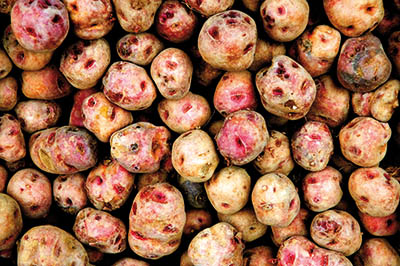From the report “Extreme salinity as a challenge to grow potatoes under Mars-like soil conditions: targeting promising genotypes“, of Ramírez, D.A.; Kreuze, J.; Amoros, W.; Valdivia-Silva, J.E.; Ranck, J.; Garcia, S.; Salas, E.; Yactayo, W. , published at International Journal of Astrobiology.
National Aeronautics and Space Administration (NASA) has invested considerable resources (crops identification, growth chambers design, food processing equipment, among others) to guarantee fresh crops growth through bioregenerative food systems (BFS) for future missions to Mars. Although, BFS were mainly focused on artificial growing medias (hydroponics, aeroponics, zeoponics, membrane systems), soil-based agriculture (SBA, i.e. using real soil growing media) has become increasingly relevant, achieving even higher productivity in some crops.
Some authors have pointed out that SBA using in-situ available resource of Martian surface is an important way to guarantee long-term sustainability for the future Martian colony. Mars today is a cold, dry desert world with surface conditions that are not habitable for even the hardiest known life forms from Earth, however, there is evidence of past (or may be present) water activity and the presence of interesting niches for life (e.g., such as subsurface and/or evaporitic minerals). Moreover, the Martian regolith is very salty and contains exotic salts such as sulphates and perchlorates becomes a major challenge for its use in agriculture. In this context, the use of terrestrial analogues of Martian surface constitutes an important effort to know and solve limitations to get SBA in the future.
One of the future challenges to produce food in a Mars environment will be the optimization of resources through the potential use of the Martian substratum for growing crops as a part of bioregenerative food systems.
In vitro plantlets from 65 potato genotypes were rooted in peat-pellets substratum and transplanted in pots filled with Mars-like soil from La Joya desert in Southern Peru. The Mars-like soil was characterized by extreme salinity (an electric conductivity of 19.3 and 52.6 dS m−1 under 1 : 1 and saturation extract of the soil solution, respectively) and plants grown in it were under sub-optimum physiological status indicated by average maximum stomatal conductance <50 mmol H2O m−2 s−1 even after irrigation. 40% of the genotypes survived and yielded (0.3–5.2 g tuber plant−1) where CIP.397099.4, CIP.396311.1 and CIP.390478.9 were targeted as promising materials with 9.3, 8.9 and 5.8% of fresh tuber yield in relation to the control conditions.

A combination of appropriate genotypes and soil management will be crucial to withstand extreme salinity, a problem also important in agriculture on Earth that requires more detailed follow-up studies.

